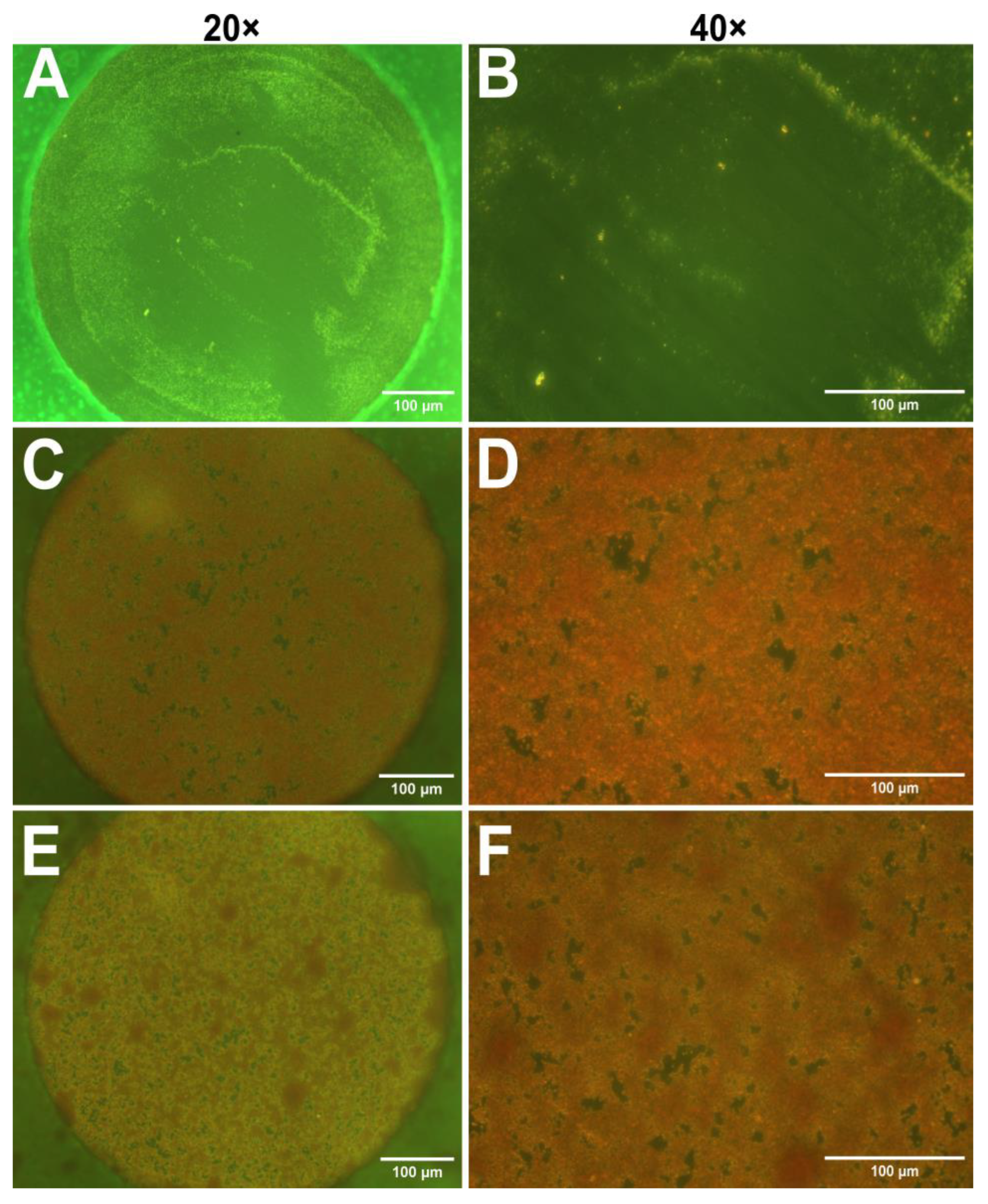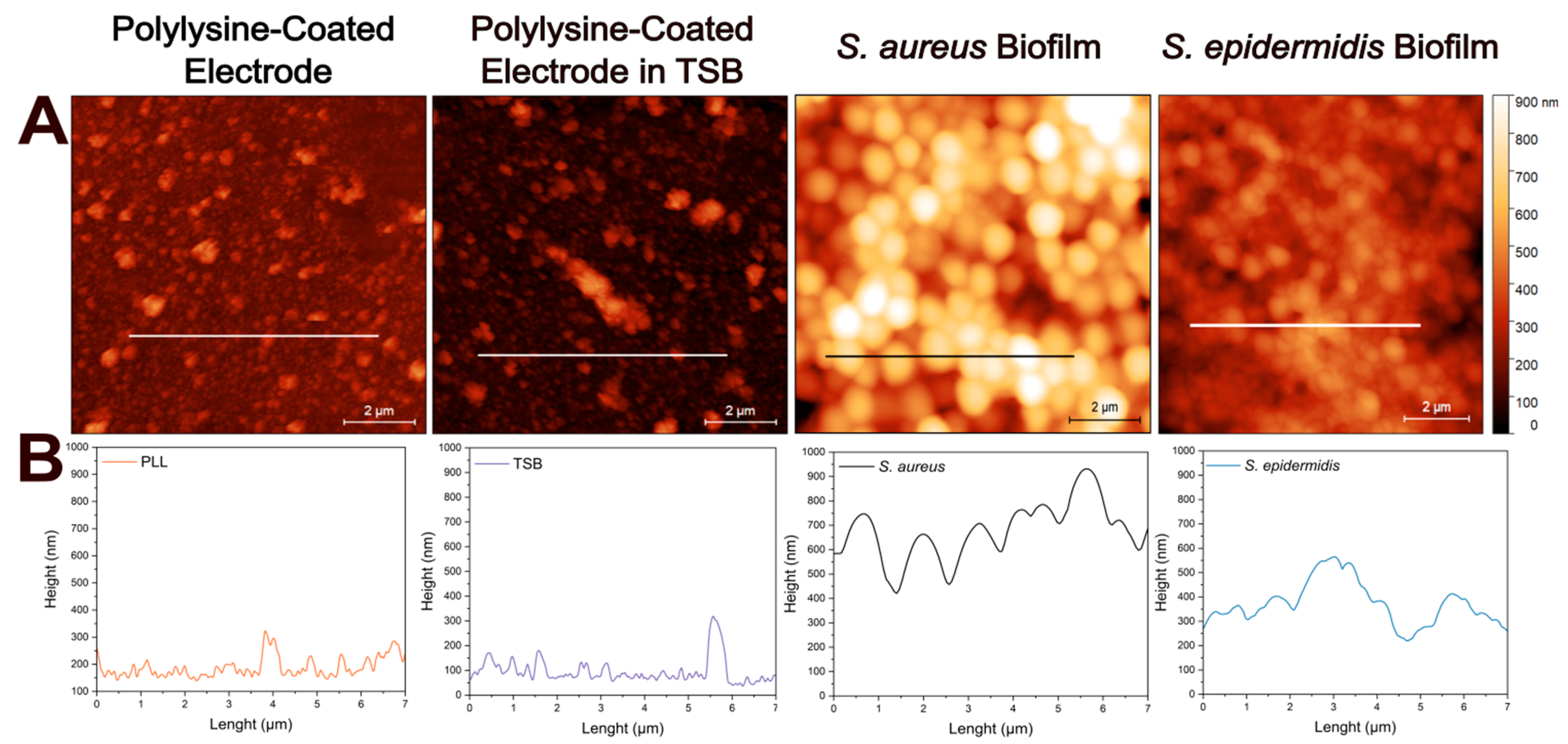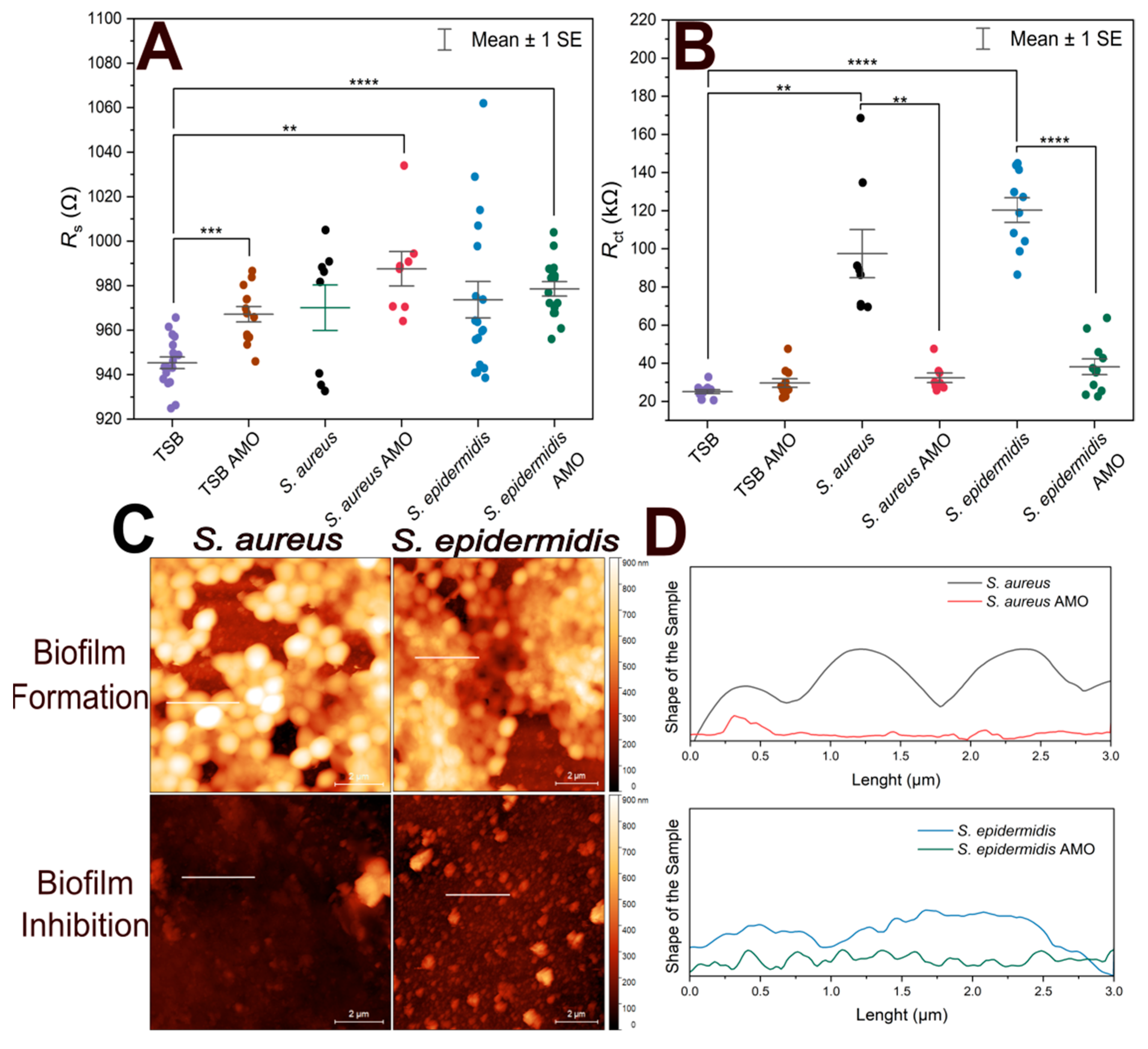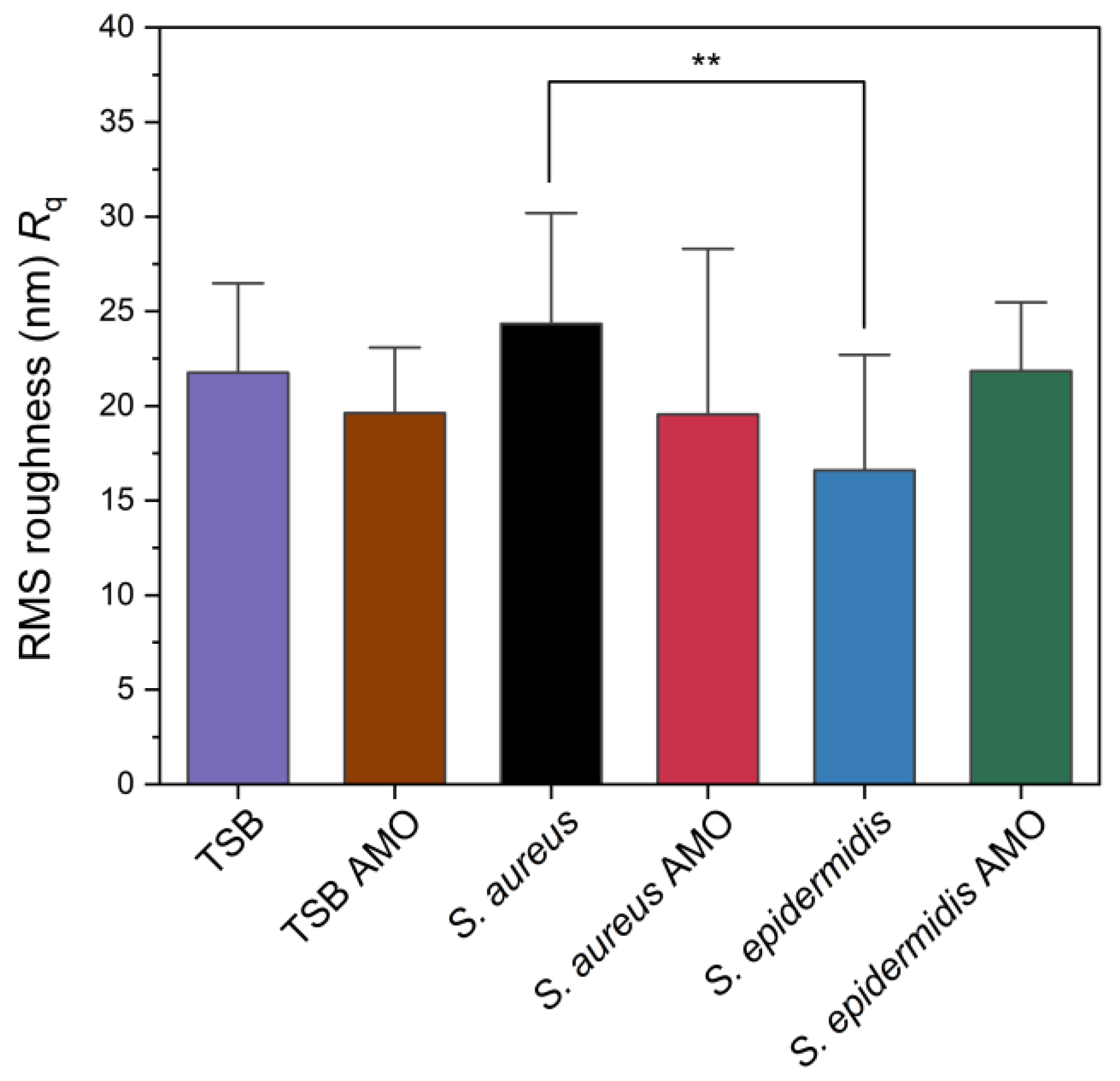Pathogen-on-a-Chip: Impedance-Based Detection of Biofilm Formation of Staphylococcus aureus and Staphylococcus epidermidis
Abstract
1. Introduction
2. Materials and Methods
2.1. Chemicals and Reagents
2.2. Bacterial Strains and Cell Culture Conditions
2.3. Electrode Surface Modification
2.4. S. aureus and S. epidermidis Biofilm Formation and Its Inhibition
2.5. Electrochemical Impedance Spectroscopy Measurements
2.6. Biofilm Evaluation Using Light Microscopy
2.7. AFM Characterization of Biofilms on Electrodes
2.8. Statistical Data Analysis
3. Results and Discussion
3.1. Electrochemical Evaluation of Biofilms
3.2. Validation of Biofilm Formation on Electrodes
3.3. Inhibition of Biofilm Formation
4. Conclusions
Author Contributions
Funding
Institutional Review Board Statement
Informed Consent Statement
Data Availability Statement
Acknowledgments
Conflicts of Interest
References
- Mahto, K.U.; Vandana; Priyadarshanee, M.; Samantaray, D.P.; Das, S. Bacterial Biofilm and Extracellular Polymeric Substances in the Treatment of Environmental Pollutants: Beyond the Protective Role in Survivability. J. Clean. Prod. 2022, 379, 134759. [Google Scholar] [CrossRef]
- Wang, Y.; Bian, Z.; Wang, Y. Biofilm Formation and Inhibition Mediated by Bacterial Quorum Sensing. Appl. Microbiol. Biotechnol. 2022, 106, 6365–6381. [Google Scholar] [CrossRef]
- Karygianni, L.; Ren, Z.; Koo, H.; Thurnheer, T. Biofilm Matrixome: Extracellular Components in Structured Microbial Communities. Trends Microbiol. 2020, 28, 668–681. [Google Scholar] [CrossRef]
- Guzmán-Soto, I.; McTiernan, C.; Gonzalez-Gomez, M.; Ross, A.; Gupta, K.; Suuronen, E.J.; Mah, T.-F.; Griffith, M.; Alarcon, E.I. Mimicking Biofilm Formation and Development: Recent Progress in in vitro and in vivo Biofilm Models. iScience 2021, 24, 102443. [Google Scholar] [CrossRef]
- Kreve, S.; Reis, A.C.D. Bacterial Adhesion to Biomaterials: What Regulates This Attachment? A Review. Jpn. Dent. Sci. Rev. 2021, 57, 85–96. [Google Scholar] [CrossRef]
- Wang, C.; Hou, J.; van der Mei, H.C.; Busscher, H.J.; Ren, Y. Emergent Properties in Streptococcus mutans Biofilms Are Controlled through Adhesion Force Sensing by Initial Colonizers. mBio 2019, 10, 10-1128. [Google Scholar] [CrossRef]
- Palmer, J.; Flint, S.; Brooks, J. Bacterial Cell Attachment, the Beginning of a Biofilm. J. Ind. Microbiol. Biotechnol. 2007, 34, 577–588. [Google Scholar] [CrossRef] [PubMed]
- Theis, T.J.; Daubert, T.A.; Kluthe, K.E.; Brodd, K.L.; Nuxoll, A.S. Staphylococcus aureus Persisters Are Associated with Reduced Clearance in a Catheter-Associated Biofilm Infection. Front. Cell Infect. Microbiol. 2023, 13, 1178526. [Google Scholar] [CrossRef] [PubMed]
- Conlon, B.P. Staphylococcus aureus Chronic and Relapsing Infections: Evidence of a Role for Persister Cells: An Investigation of Persister Cells, Their Formation and Their Role in S. aureus Disease. BioEssays 2014, 36, 991–996. [Google Scholar] [CrossRef]
- Lewis, K. Persister Cells, Dormancy and Infectious Disease. Nat. Rev. Microbiol. 2007, 5, 48–56. [Google Scholar] [CrossRef] [PubMed]
- Zhao, A.; Sun, J.; Liu, Y. Understanding Bacterial Biofilms: From Definition to Treatment Strategies. Front. Cell Infect. Microbiol. 2023, 13, 1137947. [Google Scholar] [CrossRef] [PubMed]
- Rather, M.A.; Gupta, K.; Mandal, M. Microbial Biofilm: Formation, Architecture, Antibiotic Resistance, and Control Strategies. Braz. J. Microbiol. 2021, 52, 1701–1718. [Google Scholar] [CrossRef]
- Del Pozo, J.L. Biofilm-Related Disease. Expert. Rev. Anti Infect. Ther. 2018, 16, 51–65. [Google Scholar] [CrossRef]
- Severn, M.M.; Horswill, A.R. Staphylococcus epidermidis and Its Dual Lifestyle in Skin Health and Infection. Nat. Rev. Microbiol. 2023, 21, 97–111. [Google Scholar] [CrossRef]
- Idrees, M.; Sawant, S.; Karodia, N.; Rahman, A. Staphylococcus aureus Biofilm: Morphology, Genetics, Pathogenesis and Treatment Strategies. Int. J. Environ. Res. Public Health 2021, 18, 7602. [Google Scholar] [CrossRef] [PubMed]
- Diepoltová, A.; Konečná, K.; Janďourek, O.; Nachtigal, P. Study of the Impact of Cultivation Conditions and Peg Surface Modification on the in vitro Biofilm Formation of Staphylococcus aureus and Staphylococcus epidermidis in a System Analogous to the Calgary Biofilm Device. J. Med. Microbiol. 2021, 70, 001371. [Google Scholar] [CrossRef] [PubMed]
- Arciola, C.R.; Campoccia, D.; Montanaro, L. Detection of Biofilm-Forming Strains of Staphylococcus epidermidis and S. aureus. Expert. Rev. Mol. Diagn. 2002, 2, 478–484. [Google Scholar] [CrossRef]
- Khatoon, Z.; McTiernan, C.D.; Suuronen, E.J.; Mah, T.-F.; Alarcon, E.I.; Alarcon Bacterial, E.I. Bacterial Biofilm Formation on Implantable Devices and Approaches to Its Treatment and Prevention. Heliyon 2018, 4, 1067. [Google Scholar] [CrossRef]
- Li, G.; Wu, Y.; Li, Y.; Hong, Y.; Zhao, X.; Reyes, P.I.; Lu, Y. Early Stage Detection of Staphylococcus epidermidis Biofilm Formation Using MgZnO Dual-Gate TFT Biosensor. Biosens. Bioelectron. 2020, 151, 111993. [Google Scholar] [CrossRef]
- Guła, G.; Szymanowska, P.; Piasecki, T.; Góras, S.; Gotszalk, T.; Drulis-Kawa, Z. The Application of Impedance Spectroscopy for Pseudomonas Biofilm Monitoring during Phage Infection. Viruses 2020, 12, 407. [Google Scholar] [CrossRef]
- Achinas, S.; Yska, S.K.; Charalampogiannis, N.; Krooneman, J.; Euverink, G.J.W. A Technological Understanding of Biofilm Detection Techniques: A Review. Materials 2020, 13, 3147. [Google Scholar] [CrossRef]
- Ameer, S.; Ibrahim, H.; Yaseen, M.U.; Kulsoom, F.; Cinti, S.; Sher, M. Electrochemical Impedance Spectroscopy-Based Sensing of Biofilms: A Comprehensive Review. Biosensors 2023, 13, 777. [Google Scholar] [CrossRef]
- Nag, M.; Lahiri, D. Analytical Methodologies for Biofilm Research, 1st ed.; Springer: New York, NY, USA, 2021; ISBN 978-1-0716-1378-8. [Google Scholar]
- Kretzschmar, J.; Harnisch, F. Electrochemical Impedance Spectroscopy on Biofilm Electrodes—Conclusive or Euphonious? Curr. Opin. Electrochem. 2021, 29, 100757. [Google Scholar] [CrossRef]
- Romero, M.C.; Méndez-Tovar, M. Impedance Analysis for the Study of Biofilm Formation on Electrodes: An Overview. J. Mex. Chem. Soc. 2023, 67, 547–565. [Google Scholar] [CrossRef]
- Xu, W.; Ceylan Koydemir, H. Non-Invasive Biomedical Sensors for Early Detection and Monitoring of Bacterial Biofilm Growth at the Point of Care. Lab. Chip 2022, 22, 4758–4773. [Google Scholar] [CrossRef]
- Swami, P.; Anand, S.; Holani, A.; Gupta, S. Impedance Spectroscopy for Bacterial Cell Monitoring, Analysis, and Antibiotic Susceptibility Testing. Langmuir 2024, 40, 21907–21930. [Google Scholar] [CrossRef]
- Paredes, J.; Becerro, S.; Arana, S. Comparison of Real Time Impedance Monitoring of Bacterial Biofilm Cultures in Different Experimental Setups Mimicking Real Field Environments. Sens. Actuators B Chem. 2014, 195, 667–676. [Google Scholar] [CrossRef]
- McGlennen, M.; Dieser, M.; Foreman, C.M.; Warnat, S. Monitoring Biofilm Growth and Dispersal in Real-Time with Impedance Biosensors. J. Ind. Microbiol. Biotechnol. 2023, 50, kuad022. [Google Scholar] [CrossRef] [PubMed]
- Ward, A.C.; Hannah, A.J.; Kendrick, S.L.; Tucker, N.P.; MacGregor, G.; Connolly, P. Identification and Characterisation of Staphylococcus aureus on Low Cost Screen Printed Carbon Electrodes Using Impedance Spectroscopy. Biosens. Bioelectron. 2018, 110, 65–70. [Google Scholar] [CrossRef]
- Kim, T.; Kang, J.; Lee, J.H.; Yoon, J. Influence of Attached Bacteria and Biofilm on Double-Layer Capacitance during Biofilm Monitoring by Electrochemical Impedance Spectroscopy. Water Res. 2011, 45, 4615–4622. [Google Scholar] [CrossRef]
- Lacina, K.; Věžník, J.; Sopoušek, J.; Farka, Z.; Lacinová, V.; Skládal, P. Concentration and Diffusion of the Redox Probe as Key Parameters for Label-Free Impedimetric Immunosensing. Bioelectrochemistry 2023, 149, 108308. [Google Scholar] [CrossRef]
- Obořilová, R.; Šimečková, H.; Pastucha, M.; Klimovič, Š.; Víšová, I.; Přibyl, J.; Vaisocherová-Lísalová, H.; Pantůček, R.; Skládal, P.; Mašlaňová, I.; et al. Atomic Force Microscopy and Surface Plasmon Resonan Ce for Real-Time Single-Cell Monitoring of Bacteriophage-Mediated Lysis of Bacteria. Nanoscale 2021, 13, 13538–13549. [Google Scholar] [CrossRef]
- Sopoušek, J.; Věžník, J.; Houser, J.; Skládal, P.; Lacina, K. Crucial Factors Governing the Electrochemical Impedance on Protein-Modified Surfaces. Electrochim. Acta 2021, 388, 138616. [Google Scholar] [CrossRef]
- Standar, K.; Kreikemeyer, B.; Redanz, S.; Münter, W.L.; Laue, M.; Podbielski, A. Setup of an in vitro Test System for Basic Studies on Biofilm Behavior of Mixed-Species Cultures with Dental and Periodontal Pathogens. PLoS ONE 2010, 5, e13135. [Google Scholar] [CrossRef]
- Obořilová, R.; Kučerová, E.; Botka, T.; Vaisocherová-Lísalová, H.; Skládal, P.; Farka, Z. Piezoelectric Biosensor with Dissipation Monitoring Enables the Analysis of Bacterial Lytic Agent Activity. Sci. Rep. 2025, 15, 3419. [Google Scholar] [CrossRef]
- Deng, M.; Wang, Y.; Chen, G.; Liu, J.; Wang, Z.; Xu, H. Poly-L-Lysine-Functionalized Magnetic Beads Combined with Polymerase Chain Reaction for the Detection of Staphylococcus aureus and Escherichia coli O157:H7 in Milk. J. Dairy Sci. 2021, 104, 12342–12352. [Google Scholar] [CrossRef]
- Marka, S.; Zografaki, M.E.; Papaioannou, G.M.; Mavrikou, S.; Flemetakis, E.; Kintzios, S. Impedance In vitro Assessment for the Detection of Salmonella typhimurium Infection in Intestinal Human Cancer Cells. Chemosensors 2023, 11, 534. [Google Scholar] [CrossRef]
- Kim, B.R.; Bae, Y.M.; Lee, S.Y. Effect of Environmental Conditions on Biofilm Formation and Related Characteristics of Staphylococcus aureus. J. Food Saf. 2016, 36, 412–422. [Google Scholar] [CrossRef]
- Oliver, L.M.; Dunlop, P.S.M.; Byrne, J.A.; Blair, I.S.; Boyle, M.; Mcguigan, K.G.; Mcadams, E.T. An Impedimetric Sensor for Monitoring the Growth of Staphylococcus epidermidis. In Proceedings of the 2006 International Conference of the IEEE Engineering in Medicine and Biology Society, New York, NY, USA, 30 August–3 September 2006; pp. 535–538. [Google Scholar]
- Lofrumento, C.; Arci, F.; Carlesi, S.; Ricci, M.; Castellucci, E.; Becucci, M. Safranin-O Dye in the Ground State. A Study by Density Functional Theory, Raman, SERS and Infrared Spectroscopy. Spectrochim. Acta A Mol. Biomol. Spectrosc. 2015, 137, 677–684. [Google Scholar] [CrossRef] [PubMed]
- Ommen, P.; Zobek, N.; Meyer, R.L. Quantification of Biofilm Biomass by Staining: Non-Toxic Safranin Can Replace the Popular Crystal Violet. J. Microbiol. Methods 2017, 141, 87–89. [Google Scholar] [CrossRef] [PubMed]
- James, S.A.; Powell, L.C.; Wright, C.J. Atomic Force Microscopy of Biofilms—Imaging, Interactions, and Mechanics. In Microbial Biofilms—Importance and Applications; InTech: Rijeka, Croatia, 2016. [Google Scholar]
- Tollersrud, T.; Berge, T.; Andersen, S.R.; Lund, A. Imaging the Surface of Staphylococcus aureus by Atomic Force Microscopy. APMIS 2001, 109, 541–545. [Google Scholar] [CrossRef] [PubMed]
- Chatterjee, S.; Biswas, N.; Datta, A.; Dey, R.; Maiti, P. Atomic Force Microscopy in Biofilm Study. Microscopy 2014, 63, 269–278. [Google Scholar] [CrossRef] [PubMed]





| Equivalent Circuit | Control | Biofilm 1 | Biofilm 2 |
|---|---|---|---|
| Rs(RctC) | χ2 = 0.014 | χ2 = 0.013 | χ2 = 0.014 |
 | Rs = 1.04 (5.5) Rct = 67.0 (4.1) C = 14.3 (4.3) | Rs = 0.996 (5.4) Rct = 109 (4.5) C = 18.5 (4.1) | Rs = 0.995 (5.5) Rct = 88.8 (4.3) C = 16.6 (4.2) |
| Rs([RctW]C) | χ2 = 0.0040 | χ2 = 0.33 | χ2 = 0.37 |
 | Rs = 1.03 (3.0) Rct = 60.1 (3.0) C = 14.0 (2.4) W = 60.3 (16) | Rs = 0.93 (na) Rct = 10−6 (inf) C = 6.7 (60) W = 477 (22) | Rs = 0.91 (na) Rct = 10−6 (inf) C = 5.2 (87) W = 408 (22) |
| Rs(R1C1)(RctC) | χ2 = 0.0054 | χ2 = 0.0054 | χ2 = 0.0059 |
 | Rs = 1.04 (3.5) R1 = 21.9 (21) C1 = 1250 (38) Rct = 60.4 (4.1) C = 14.3 (2.8) | Rs = 0.98 (3.4) R1 = 105 (4.6) C1 = 25.7 (11) Rct = 8.32 (51) C = 47.9 (3.6) | Rs = 0.99 (3.6) R1 = 41.8 (23) C1 = 127 (54) Rct = 56.0 (18) C = 18 (7.7) |
| Rs([RctW]Q) | χ2 = 0.00030 | χ2 = 0.00010 | χ2 = 0.00050 |
 (Randles) | Rs = 0.99 (0.90) Rct = 63.9 (0.90) W = 47.8 (5.9) Q = 21.8 (3.1) n = 0.95 (0.3) | Rs = 0.94 (0.60) Rct = 108 (0.70) W = 49.9 (6.6) Q = 30.4 (1.9) n = 0.94 (0.20) | Rs = 0.94 (1.2) Rct = 86.4 (1.4) W = 52.5 (10) Q = 26.3 (3.9) n = 0.94 (0.40) |
| Sample | Coverage Area (µm2) | Max. Profile Height (µm) |
|---|---|---|
| S. epidermidis 10 min | 18.4 ± 7.7 | 0.74 ± 0.068 |
| S. epidermidis 1 h | 88 ± 15 | 0.66 ± 0.13 |
| S. epidermidis with AMO | 0 | 0.24 ± 0.036 |
| S. aureus 10 min | 72 ± 23 | 0.86 ± 0.11 |
| S. aureus 1 h | 80 ± 24 | 1.0 ± 0.051 |
| S. aureus with AMO | 1.3 ± 1.8 | 0.46 ± 0.18 |
Disclaimer/Publisher’s Note: The statements, opinions and data contained in all publications are solely those of the individual author(s) and contributor(s) and not of MDPI and/or the editor(s). MDPI and/or the editor(s) disclaim responsibility for any injury to people or property resulting from any ideas, methods, instructions or products referred to in the content. |
© 2025 by the authors. Licensee MDPI, Basel, Switzerland. This article is an open access article distributed under the terms and conditions of the Creative Commons Attribution (CC BY) license (https://creativecommons.org/licenses/by/4.0/).
Share and Cite
Yöney, B.; Obořilová, R.; Lacina, K.; Farka, Z.; Skládal, P. Pathogen-on-a-Chip: Impedance-Based Detection of Biofilm Formation of Staphylococcus aureus and Staphylococcus epidermidis. Biosensors 2025, 15, 596. https://doi.org/10.3390/bios15090596
Yöney B, Obořilová R, Lacina K, Farka Z, Skládal P. Pathogen-on-a-Chip: Impedance-Based Detection of Biofilm Formation of Staphylococcus aureus and Staphylococcus epidermidis. Biosensors. 2025; 15(9):596. https://doi.org/10.3390/bios15090596
Chicago/Turabian StyleYöney, Bengisu, Radka Obořilová, Karel Lacina, Zdeněk Farka, and Petr Skládal. 2025. "Pathogen-on-a-Chip: Impedance-Based Detection of Biofilm Formation of Staphylococcus aureus and Staphylococcus epidermidis" Biosensors 15, no. 9: 596. https://doi.org/10.3390/bios15090596
APA StyleYöney, B., Obořilová, R., Lacina, K., Farka, Z., & Skládal, P. (2025). Pathogen-on-a-Chip: Impedance-Based Detection of Biofilm Formation of Staphylococcus aureus and Staphylococcus epidermidis. Biosensors, 15(9), 596. https://doi.org/10.3390/bios15090596







